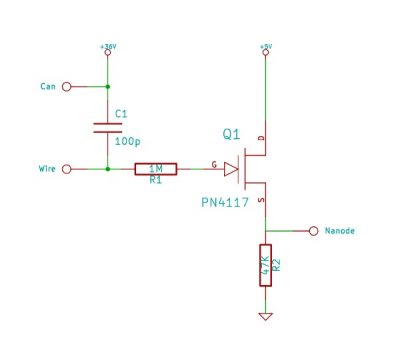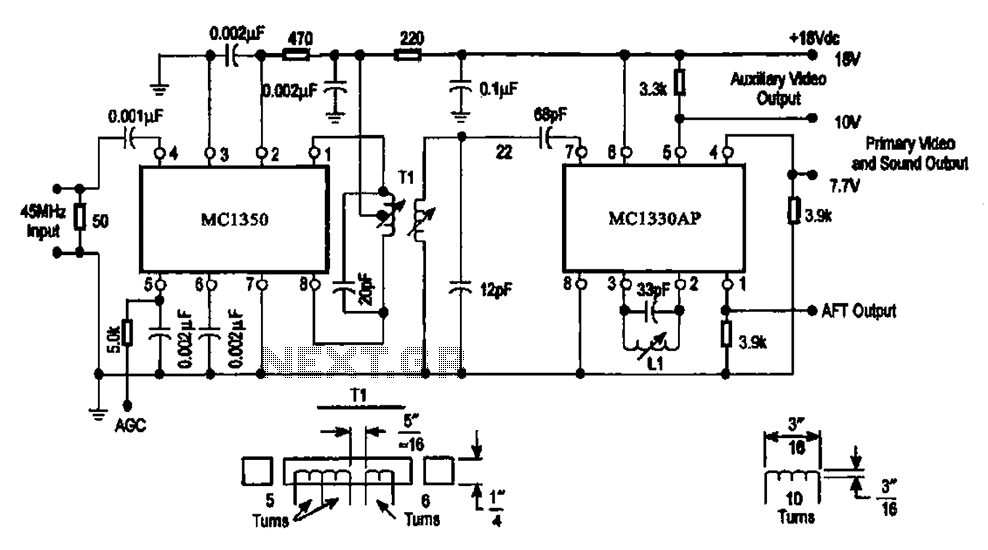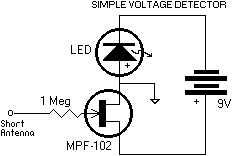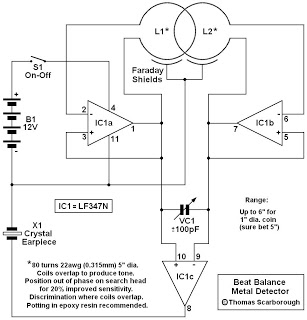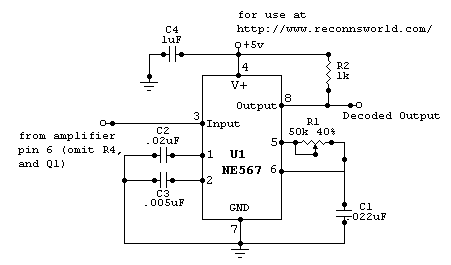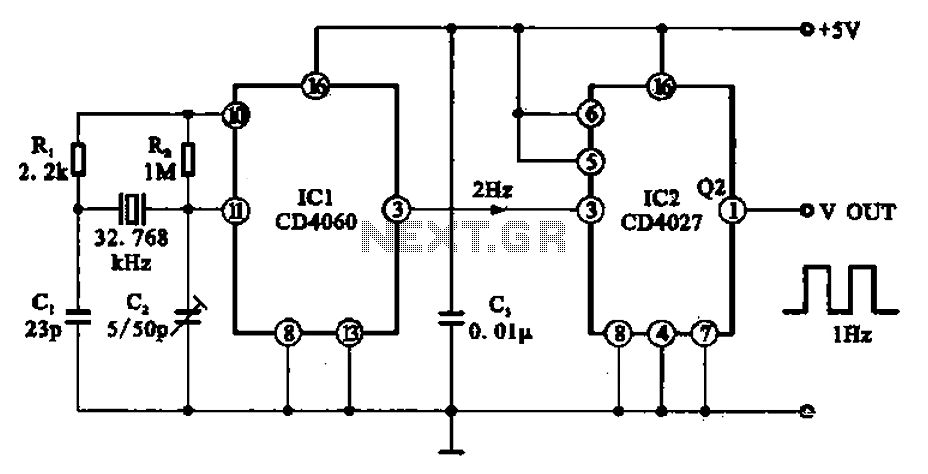
Radar signal detector
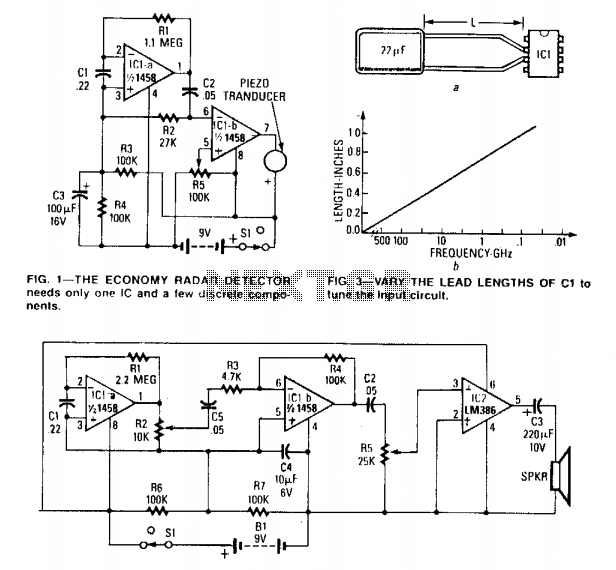
The circuit can be tuned to respond to signals between 50 MHz and 500 GHz. The economy model is illustrated in Figure 1, while the deluxe model is depicted in Figure 2. The first operational amplifier (op-amp) in each circuit operates as a current-to-voltage converter. In the economy model, IC1b buffers the output to drive the piezo buzzer. The deluxe model operates similarly, but IC1b is configured as a 20x buffer amplifier to drive the LM386. In both circuits, C1 functions as a "transmission line" that intercepts the incoming radar signal. The response may be optimized by trimming the lead length of C1 for the desired frequency, with typical lead lengths ranging from 0.5 to 0.6 inches.
The described circuit is designed to operate effectively across a broad frequency range, specifically from 50 MHz to 500 GHz. This versatility makes it suitable for various applications, including radar signal processing and communication systems. The economy model and deluxe model configurations differ primarily in their output amplification stages, with the economy model utilizing a simple buffer to drive a piezo buzzer, while the deluxe model employs an LM386 amplifier for enhanced audio output.
In the economy model, the first operational amplifier serves as a current-to-voltage converter, transforming the incoming radar signal into a usable voltage level. This signal is then buffered by IC1b, ensuring that the piezo buzzer receives a stable and sufficient signal for operation. The design of the circuit allows for straightforward integration into systems requiring basic signal detection and audio output.
Conversely, the deluxe model enhances this functionality by incorporating a 20x buffer amplifier configuration. This setup allows for greater amplification of the signal, enabling the LM386 to drive more demanding loads, such as speakers or larger audio devices. The choice of the LM386 amplifier is particularly suitable due to its low power consumption and ability to deliver significant output power, making it ideal for portable or battery-operated devices.
Both models utilize capacitor C1 as a critical component in the transmission of the radar signal. This capacitor acts as a transmission line, capturing the incoming signal and facilitating its processing by the operational amplifiers. The performance of the circuit can be fine-tuned by adjusting the lead length of C1, which affects the impedance and, consequently, the frequency response of the circuit. The recommended lead length of 0.5 to 0.6 inches is a standard practice that helps optimize the circuit's performance at the desired frequency range.
Overall, the circuit's design is a practical solution for applications requiring radar signal detection and audio output, with flexibility for optimization based on specific requirements.The circuit can be tuned to respond to signals between 50 MHz and 500 GHz. The economy model is shown in Fig. 1, and the deluxe model is shown in Fig. 2.The first op amp in each circuit functions as a current-to-voltage converter. In the economy model IClb buffers the output to drive the piezo buzzer. The deluxe model functions in a similar manner except that IClb is configured as a 20 buffer amplifier to drive the LM386. In both circuits Cl functions as a "transmission line" that intercepts the incident radar signal. The response may be optimized by trimming Cl's lead length for the desired frequency. Typically the capacitor's leads should be 0.5-0.6 inches long. 🔗 External reference
The described circuit is designed to operate effectively across a broad frequency range, specifically from 50 MHz to 500 GHz. This versatility makes it suitable for various applications, including radar signal processing and communication systems. The economy model and deluxe model configurations differ primarily in their output amplification stages, with the economy model utilizing a simple buffer to drive a piezo buzzer, while the deluxe model employs an LM386 amplifier for enhanced audio output.
In the economy model, the first operational amplifier serves as a current-to-voltage converter, transforming the incoming radar signal into a usable voltage level. This signal is then buffered by IC1b, ensuring that the piezo buzzer receives a stable and sufficient signal for operation. The design of the circuit allows for straightforward integration into systems requiring basic signal detection and audio output.
Conversely, the deluxe model enhances this functionality by incorporating a 20x buffer amplifier configuration. This setup allows for greater amplification of the signal, enabling the LM386 to drive more demanding loads, such as speakers or larger audio devices. The choice of the LM386 amplifier is particularly suitable due to its low power consumption and ability to deliver significant output power, making it ideal for portable or battery-operated devices.
Both models utilize capacitor C1 as a critical component in the transmission of the radar signal. This capacitor acts as a transmission line, capturing the incoming signal and facilitating its processing by the operational amplifiers. The performance of the circuit can be fine-tuned by adjusting the lead length of C1, which affects the impedance and, consequently, the frequency response of the circuit. The recommended lead length of 0.5 to 0.6 inches is a standard practice that helps optimize the circuit's performance at the desired frequency range.
Overall, the circuit's design is a practical solution for applications requiring radar signal detection and audio output, with flexibility for optimization based on specific requirements.The circuit can be tuned to respond to signals between 50 MHz and 500 GHz. The economy model is shown in Fig. 1, and the deluxe model is shown in Fig. 2.The first op amp in each circuit functions as a current-to-voltage converter. In the economy model IClb buffers the output to drive the piezo buzzer. The deluxe model functions in a similar manner except that IClb is configured as a 20 buffer amplifier to drive the LM386. In both circuits Cl functions as a "transmission line" that intercepts the incident radar signal. The response may be optimized by trimming Cl's lead length for the desired frequency. Typically the capacitor's leads should be 0.5-0.6 inches long. 🔗 External reference
